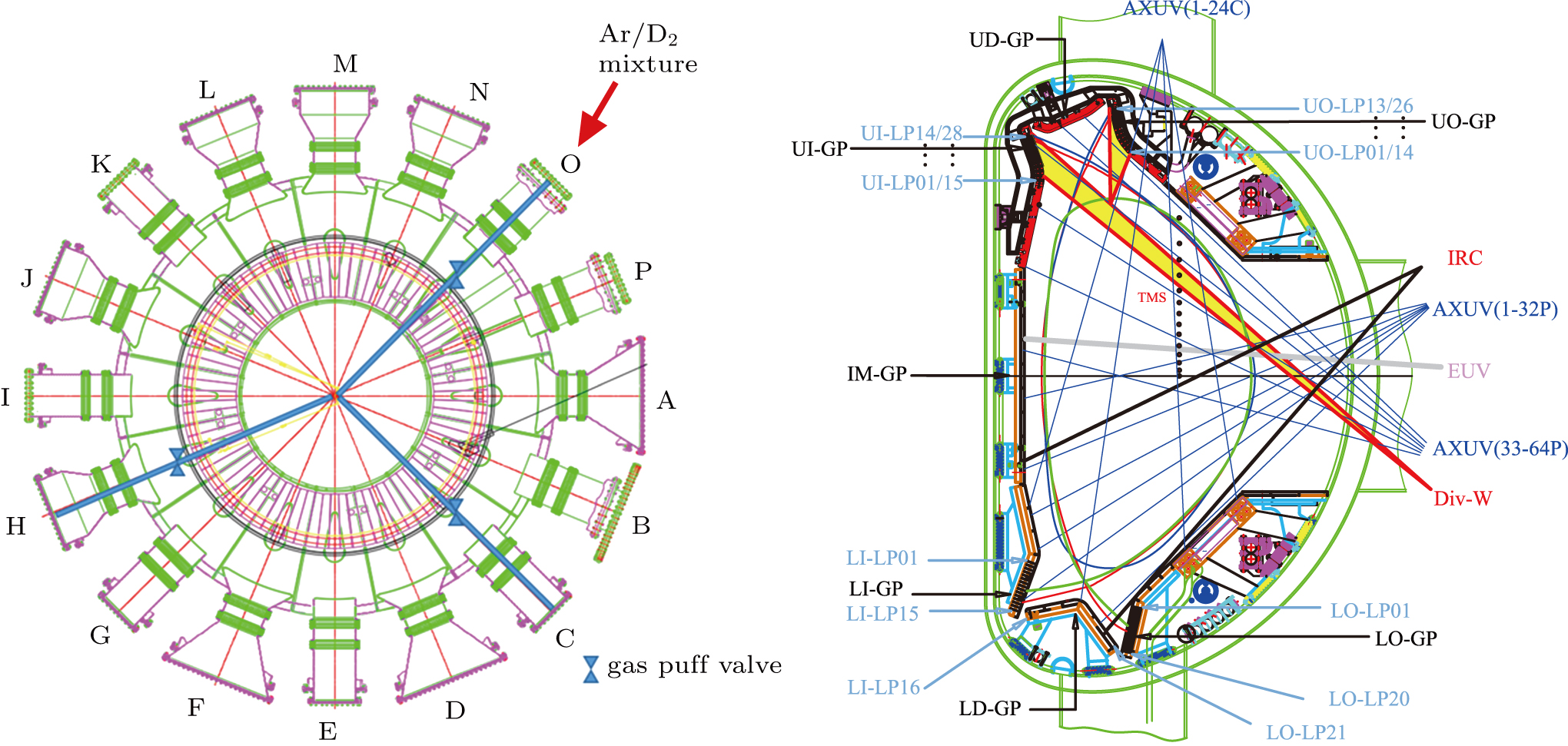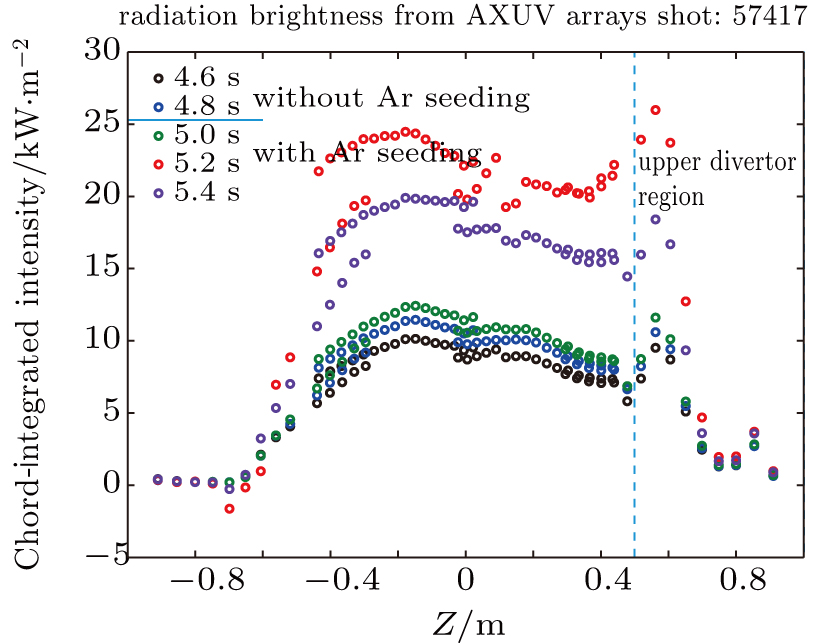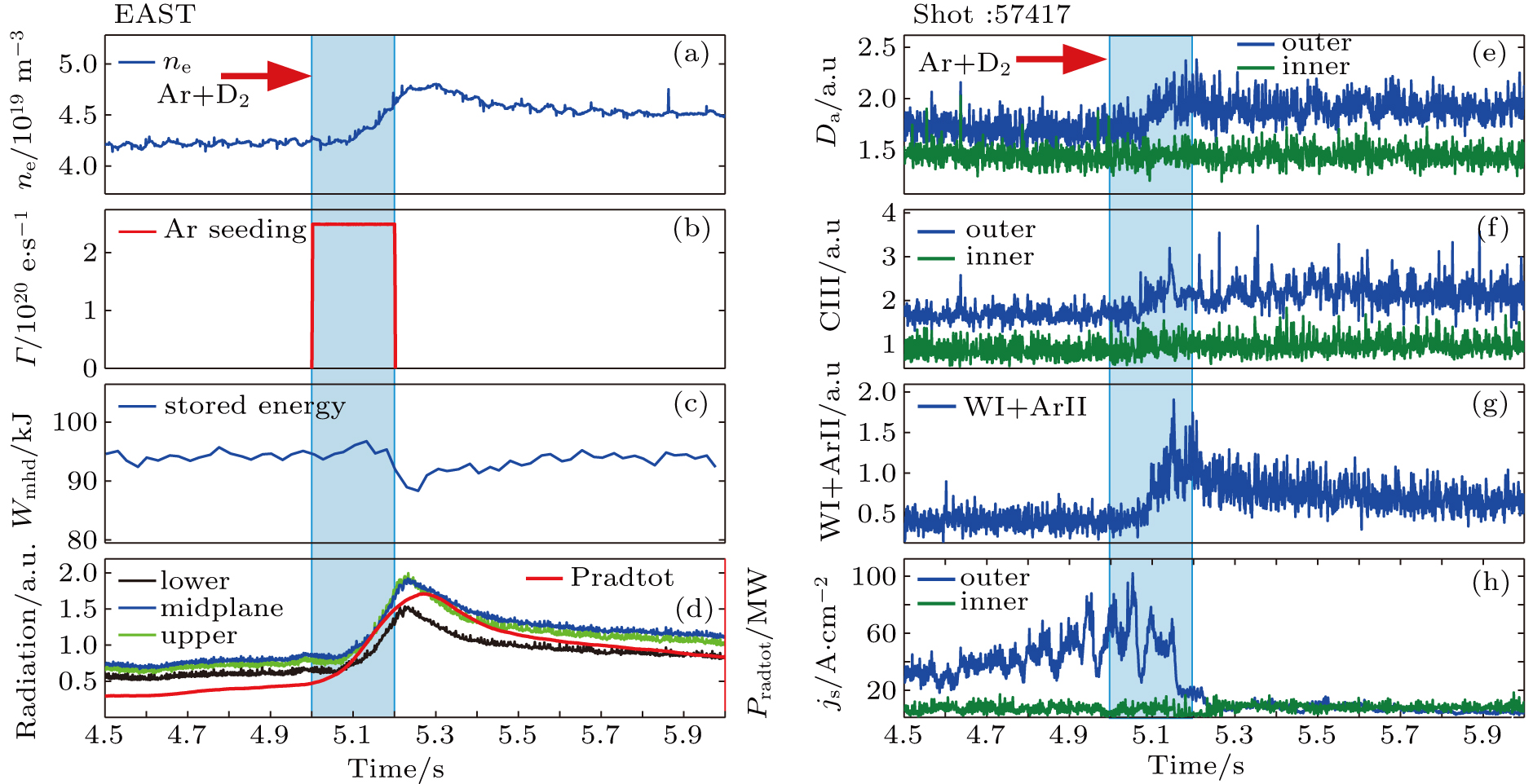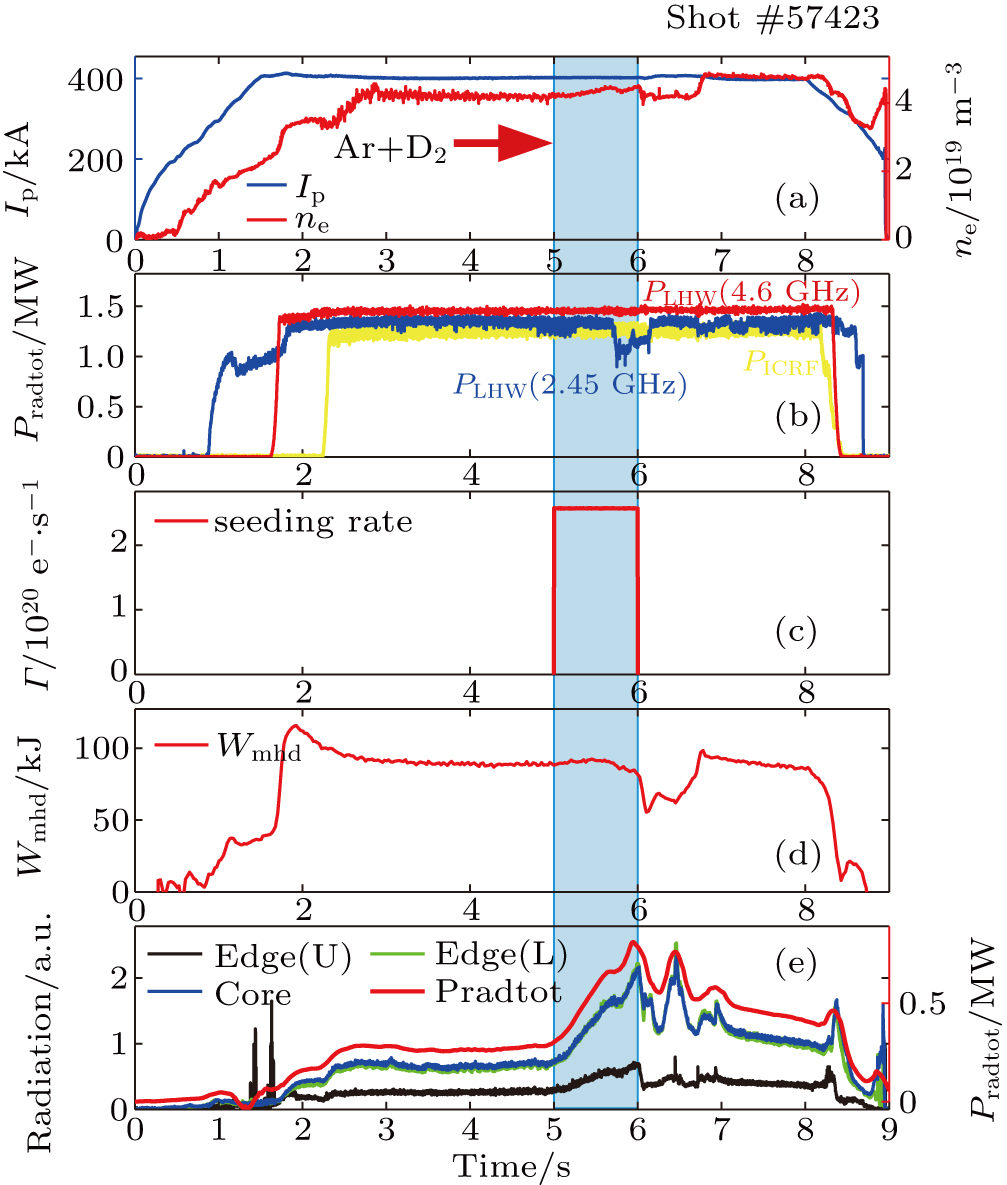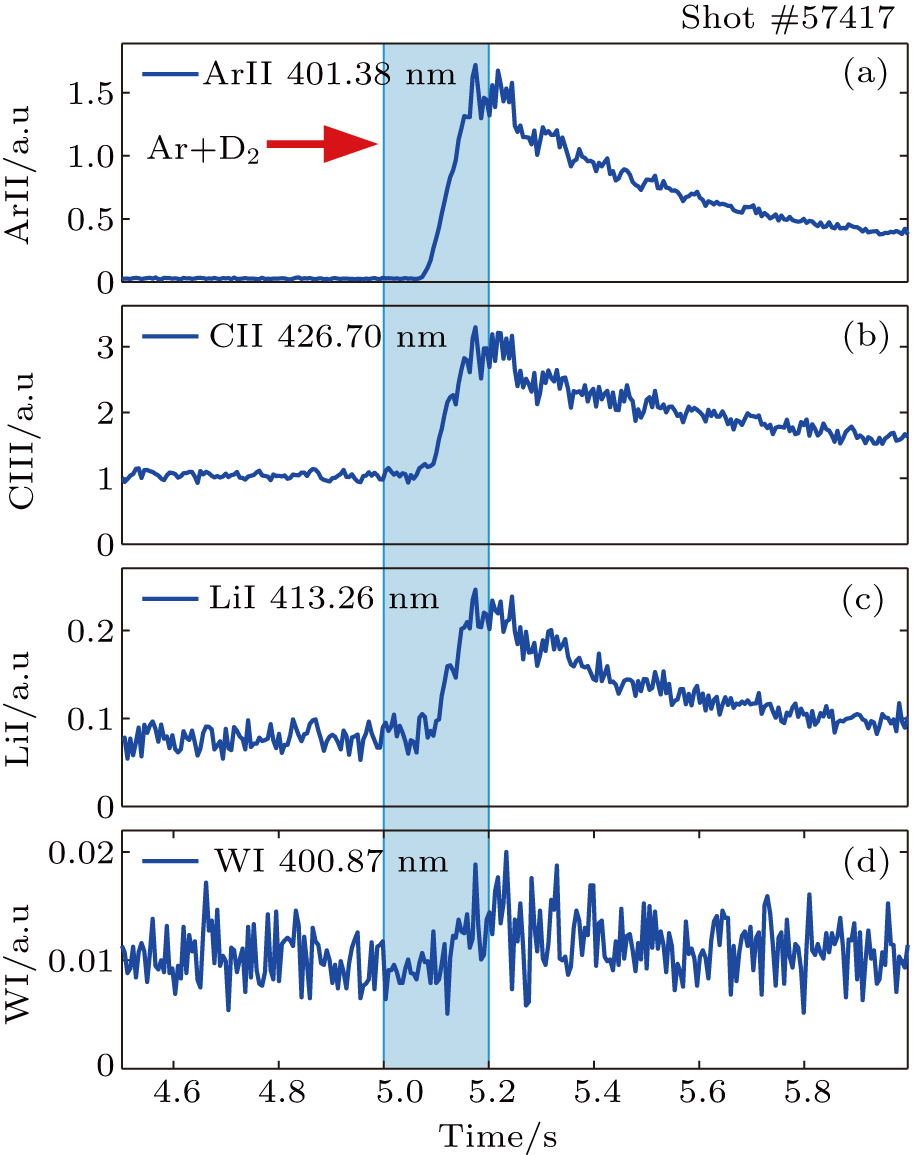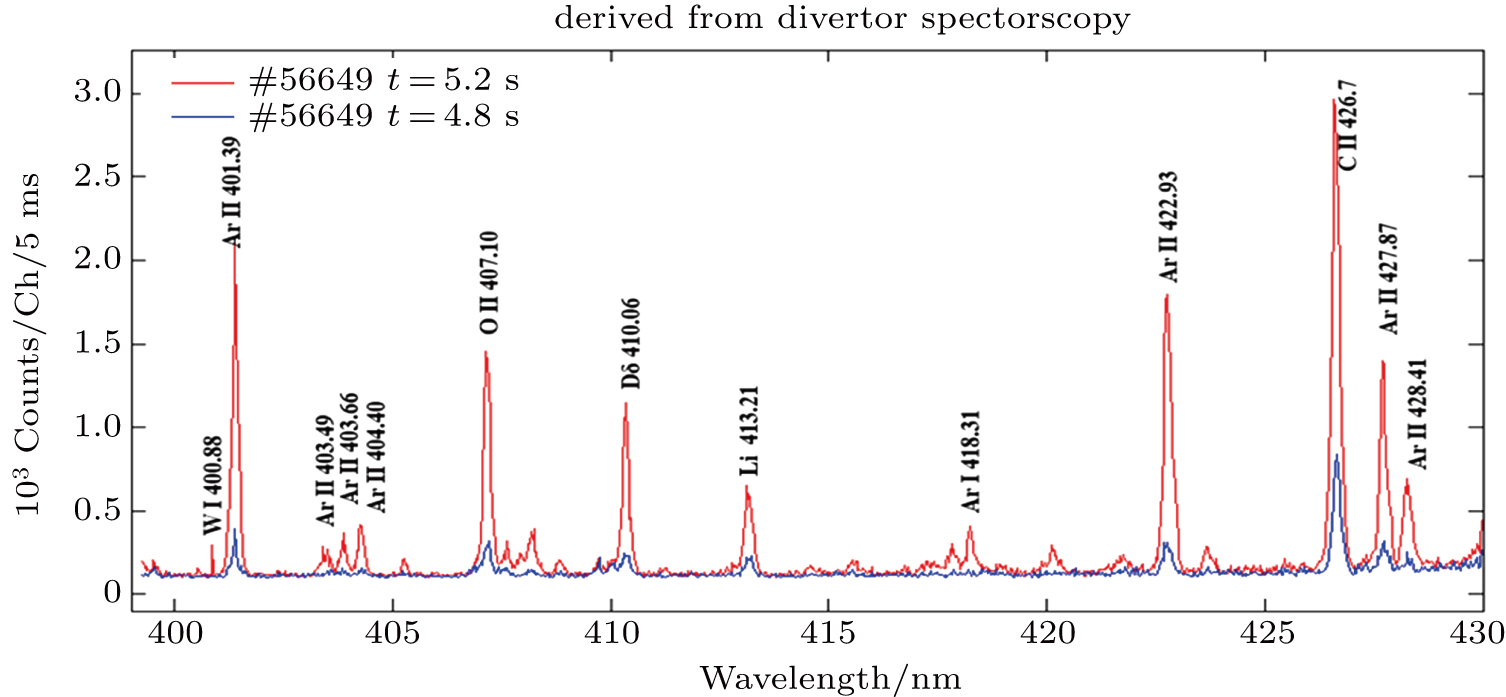† Corresponding author. E-mail:
Project supported by the National Natural Science Foundation of China (Grant Nos. 11575242, 11575243, 11505233, 11575247, and 11605238) and the National Magnetic Confinement Fusion Science Program (Grant Nos. 2013GB105002 and 2013GB105001).
To investigate the radiative divertor behavior and physics for the scenario of impurity seeded plasma in ITER, the radiative divertor experiments with argon (Ar) seeding under ITER-like tungsten divertor condition were carried out during recent EAST campaigns. The experimental results reveal the high efficiency of reducing heat load and particle flux onto the divertor targets owing to increased radiation by Ar seeding. We achieve detached plasmas in these experiments. The inner–outer divertor asymmetry reduces after Ar seeding. Impurities, such as Ar, C, Li, and W, exist in the entire space of the vacuum chamber during EAST operations, and play important roles in power exhausting and accelerating the plasma detachment process. It is remarkable that the contamination of the core plasma is observed using Ar seeding owing to the sputtering of plasma facing components (PFCs), particularly when Ar impurity is injected from the upper tungsten divertor.
Increasing divertor radiation by injecting impurity is a general and effective method for reducing the heat flux from the scrape-off layer and for cooling the divertor plasma to detachment. Impurities, such as nitrogen (N2), neon (Ne) and argon (Ar), are widely used in radiative divertor experiments on several tokamaks. In ASDEX Upgrade with full tungsten divertor wall conditions, complete and partial detached plasmas were achieved by feedback controlled N2 seeding. In addition, Ar or Ne impurities were also used to control the heat flux onto the divertor successfully.[1,2] In JET, N2 seeding was used for comparing the effect of reducing the heat load on the ITER-like wall (ILW) to that on all-carbon wall conditions. The experiment results, such as increasing the plasma density and reducing the ELM frequency and pedestal pressure with N2 seeding between two divertors, were clearly different.[3] In JT-60U, with Ne, Ar, and a mixture of Ne and Ar injection in H-mode plasmas, the fractions of divertor radiation power by these impurities besides an intrinsic impurity, C, were investigated. It was found that Ne is the dominant radiator when plasma detached by Ne seeding, but carbon acts as the biggest radiator with other impurities seeding in carbon wall conditions.[4]
The EAST has previously achieved a minute-scale noninductive H-mode in the 2016 campaign. It aims at obtaining a long pulse discharge over 1000 s with high-performance plasma in the future. In this situation, the EAST divertor faces a severe challenge owing to high heat flux; therefore, the radiative divertor experiments were conducted and investigated. Furthermore, EAST upgraded its upper divertor into actively cooled W/Cu plasma-facing components (PFCs) in 2014.[5,6] Some divertor behavior as demonstrated in the carbon divertor before is necessary to be validated in the ITER-like tungsten divertor. Owing to the routine lithium wall coating conditioning before EAST discharges, Ar, instead of N2 which easily reacts with hydrogen and lithium, was used as the seeded impurity for achieving long-pulse high-performance operations in EAST.[7–9] In this study, we introduce the radiative divertor experiments conducted during EAST 2014 and 2015 campaigns by using the mixture of Ar/D2 (1:4) as the seeded impurity. These experiments are primarily focused on investigating the divertor heat load reduction, radiation distribution, asymmetry evolution, and impurities behavior under tungsten wall conditions. From the results of the experiment, Ar proved to have high efficiency in reducing heat and particle fluxes onto the divertor targets. However, excessive Ar seeding that easily caused contamination in the core plasma region is discussed in Section
During 2014 and 2015 EAST campaigns, radiative divertor experiments were conducted in both L-mode and H-mode discharges in order to compare the differences between these two confinement modes, particularly for heat load reduction, radiation, inboard–outboard asymmetry, and impurities transport behaviors in the divertor region. As shown in Fig.
| Table 1. Coordinates of gas puff inlet. . |
Information on electron temperature, electron density, heat load, and particle flux on divertor targets were provided by the EAST divertor Langmuir probe diagnostic system consisting of 89 groups of triple probes of which the poloidal layout is shown in Fig.
As EAST upgraded its upper divertor into actively cooled W/Cu PFCs in 2014, the heating power simultaneously increased dramatically. Therefore, a considerably bigger heat load is supposed to be deposited on the divertor target. In this study, Ar seeding experiments were performed for controlling the heat flux onto the tungsten divertor target. In addition, the divertor radiation, asymmetry, and impurity transport are also investigated.
The particle flux is related to ion saturation current density js, calculated by the equation
 |
The heat flux to the target is also based on the measurement by the Langmuir probes. The parallel heat flux is given by
 |
 |
Shot#57417 was an H-mode discharge with USN divertor configuration. The drift pointed toward the top divertor, and the divertor cry-pump was activated. In this shot, Bt was fixed at 2.3 T and Ip at 0.4 MA, and the heating power was fixed at approximately 4.3 MW with the ICRF of 1.5 MW and LHW of 2.8 MW. The upstream density (in separatrix), nup,sep = 1.0 × 1019 m−3, was measured by reflectometry. Ar impurity was seeded from the upper outboard target at the rate of 2.2– 2.7 × 1020 e−/s for 200 ms. After a delay time of 100 ms, the effect of Ar started at approximately 5.1 s. At the strike point, the ion saturation current js, measured by the divertor Langmuir probe, was decreased by 60%, and the electron temperature Te decreased to less than 5 eV, because the ionization of the seeded neutral gas led to the increase of radiation to exhaust power in the divertor region.
More importantly, the heat flux, qt, onto the outer divertor target plate, which once was more than 6 MW/m2 with ELMy before Ar seeding, was clearly reduced to less than 0.5 MW/m2. The plasma was completely detached (at and near the strike point) from the upper outboard target. During gas puffing, the increase of the radiated power measured using the AXUV was approximately 350 kW in total.
Figure
The divertor asymmetry for particle and heat fluxes depends on the divertor geometry and the magnetic equilibrium, as well as the plasma shape and parameters. There is a considerably strong in–out asymmetry with considerable difference for heat and particle fluxes between the inner and the outer targets in case of the present geometry in EAST. This asymmetry is clearly evident with the increase of plasma electron density, which is proved by the previous experimental results on the machine.[17]
Figure
Deuterium line emission is frequently used for evaluating the plasma characteristics such as the density, electron temperature, and the frequency of ELMs. As shown in Fig.
Impurities, such as Ar, C, Li, and W, may exist in the entire space of the vacuum chamber during EAST operations. In the divertor and SOL regions, it is beneficial for long pulse high performance discharges to bring in moderate impurity that plays an important role in power exhausting and accelerating the plasma detachment process. Conversely, impurity in the core plasma region is harmful for the plasma confinement that may cause a considerable loss of stored energy, and then cause the plasma to go into the fluctuated state, even leading to bring disruption finally.
As Fig.
In Section
As Ar gas was injected from the upper divertor target, there was a notable increase of C and Li signals accompanying the gradually increasing Ar impurity signal observed by the divertor impurity spectroscopy. After the peak signal of the Ar intensity was approximately 5.2 s, Li decreased gradually and C either decreased rapidly. This phenomenon was attributed to the increased Ar ions flux, which was accelerated to the target by the sheath potential and produced sputtering on plasma facing components, particularly on divertor targets under the strong Li coating conditioning. The decline of Li and C impurities was also ascribed to the decrease of Ar ions because the seeded Ar cooled the plasma in the divertor region, so that less Ar could be ionized. The similar results of CIII emission in the divertor region, which are measured using the filterscope system, confirmed the phenomenon as well.
As is well known, EAST upgraded its upper divertor into actively cooled W/Cu PFCs in 2014, which consequently produced concern over how the W transport and concentration affect the plasma confinement. Typically, the tungsten sputtering was rarely observed by spectroscopy with strong Li-coating wall condition on the chamber surface. In the Shot#56649, an L-mode discharge with the LSN configuration, after Ar seeding, as shown in Fig.
In this study, the radiative divertor behavior involving the heat flux, radiation, asymmetry, and impurities was investigated by using the Ar mixture as the radiator.
The asymmetry of the particle fluxes and heat loads between inner and outer divertor reduced significantly after Ar impurity injection. In addition, the respective Ar mixture gases were seeded, from the upper and lower (carbon) divertors under similar plasma setting and heating conditions. For the lower divertor, this asymmetry is smaller than that for the top one.
Moreover, impurities were investigated. It is proved that Ar is an efficient radiator. However, there will be the risk that Ar impurity contaminates core plasma and leads to a considerable decrease of plasma stored energy. The concentration of C and Li is associated closely with the Ar injection owing to the sputtering. Unlike the carbon divertor, Ar seeding produced tungsten sputtering on the surface of the PFCs, which was observed in the experiment, and exhibited a considerable influence on plasma confinement. These results will provide a reference for future investigation on ITER discharge in the scenario of radiative divertor experiments using tungsten plasma facing components.
| [1] | |
| [2] | |
| [3] | |
| [4] | |
| [5] | |
| [6] | |
| [7] | |
| [8] | |
| [9] | |
| [10] | |
| [11] | |
| [12] | |
| [13] | |
| [14] | |
| [15] | |
| [16] | |
| [17] | |
| [18] | |
| [19] | |
| [20] | |
| [21] | |
| [22] | |
| [23] | |
| [24] |


